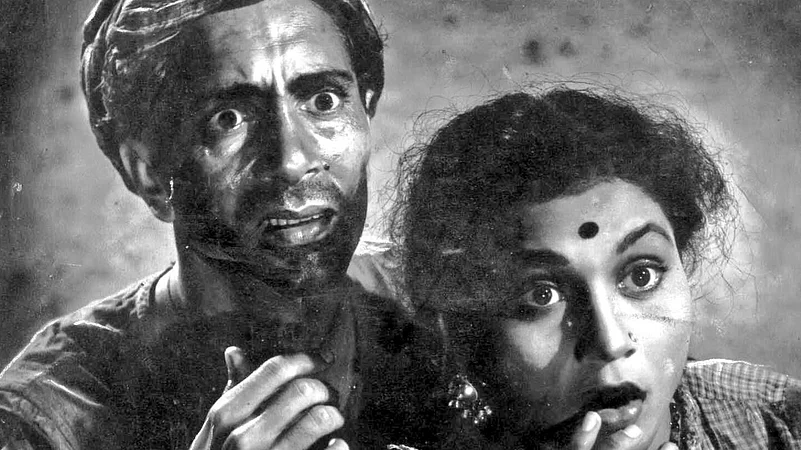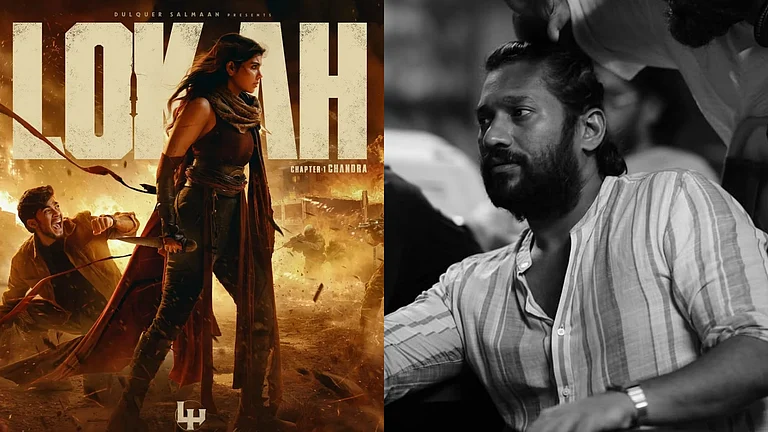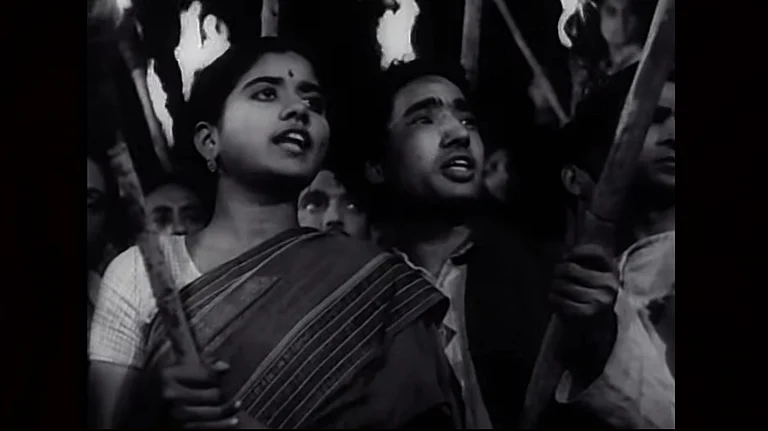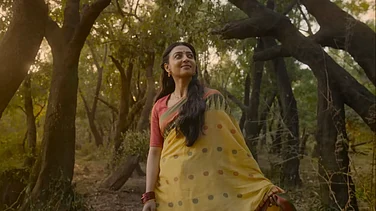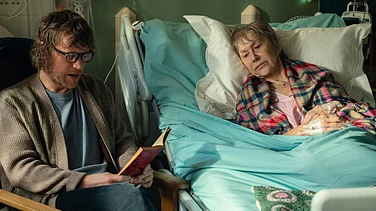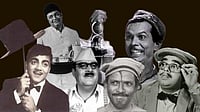Bimal Roy’s cinema has always been one of social relevance—he asks important questions through his characters, often highlighting the dichotomy of traditional societal norms and gendered expectations. Between 1952 and his death in 1966, often called the ‘golden age’ of Hindi cinema, Roy had based many of his films on the lives and issues of women.
In Do Bigha Zameen (1953), the female lead, Nirupa Roy is a peasant wife who, although uneducated, is not subservient. She is an equal partner in her husband’s agricultural pursuits and the decisions about running their household—such as him leaving for the city in search of a livelihood to help them reclaim their land, while she tends to a sick father-in-law.

In Parineeta (1953), Lalita (played by Meena Kumari) has lost her love Shekhar (Ashok Kumar) to class divide and other misunderstandings; she chooses silence and patience as a form of quiet resistance.
Biraj Bahu (1954) is the story of Biraj (Kamini Kaushal), who is failed by the system. Her husband Nilambar (Abhi Bhattacharya) is unable to confront crisis and also questions her faithfulness, asking her to leave her home. As her world falls apart, she remains steadfast in her moral clarity. Her suffering is not sentimentalised; neither is she waiting to be saved.

Some of his films, including Parineeta, Biraj Bahu and Devdas (1955) are based on Sarat Chandra’s stories/ novels and he remains true to their character in his cinematic adaptations. Women in Roy’s movies always have nuanced identities—while some represent ideal lovers (in films such as Parineeta and Madhumati), some are defiant of a normative social setup, representing different ideas and attitudes. As the women navigate the crises in their lives, they also have the agency to make choices, despite all the prevailing social prejudices of the time.

In Madhumati, the biggest hit of his career, written by Ritwik Ghatak, Vyjayanthimala essays a double role—one of the free-spirited tribal girl, Madhumati, who gets murdered and the other, her reincarnate, a modern woman, Madhavi. Although from different socioeconomic classes, they both represent how women are vulnerable to the same cycle of control and erasure through the use of power.

Bandini (1963), based on a true story, about a woman prisoner Kalyani (Nutan at her best) led to deliverance, is one of Roy's finest works and also his last. In Kalyani, Roy has carved a highly complex female character in Hindi film industry, writes Shoma A Chatterji in The Cinema of Bimal Roy: An Outsider within (2017). “Bandini is not only the prisoner in the worldly sense, albeit she is the prisoner of her mind also,” she explains. “The character of Kalyani moves from that of a woman who is a prisoner of destiny to one who defines her own freedom.”
Earlier in the film, when her brother passes away, Kalyani understands that she is the only emotional support her father has and takes on the responsibility of the household. When her father tells her that the villagers are discussing that she should be married off and made “paraya”, Kalyani says that she will not marry but study. She even asks her father if he would have worried so much had she been a boy. When Bikas (Ashok Kumar) visits her house and her father tells her to bring some sweets for him, Kalyani jokingly asks him if cooking for men is the only thing women are expected to do.
Set at a time when women had practically no choices, Kalyani has the courage to make choices in her life, even wrong ones, as she gives up everything for love. Not once does Roy try to rationalise Kalyani’s act of murder of her lover’s wife. Without being verbose and loud, Kalyani’s silence—which often overpowers the spoken word—and her self-imposed exile in jail, gives a steely patina to the character. In the end, despite the opportunity to start a new life by marrying Deven (Dharmendra), the prison doctor, Kalyani chooses otherwise. She clearly questions marriage as a choice, yearning for literal and figurative freedom. Roy faced a lot of criticism for this ending—for Kalyani choosing love over marriage and rejecting a new life—but he stood his ground.

Sujata is based on a Dalit girl raised in an upper-caste household. The depiction of caste prejudice in the film is far more humane than most films made on this subject until then. Through the soft characterization of Sujata, Roy speaks to women; she is subdued, feminine and diffident, yet grateful to her adoptive parents without knowing the truth of her status. Sujata’s character does not “reform” her caste identity to gain love; she holds her ground, forcing others to confront their prejudice. She is constantly aware of her social position but refuses to be diminished for it. Her silence is not submission—it is quiet resistance. The camera lingers on her face not as a voyeur, but as a witness to her dignity.

In the book Bimal Roy: The Man Who Spoke in Pictures (ed. Rinki Roy Bhattacharya & Anwesha Arya, 2009), film critic Maithili Rao observes that even Roy's depiction of romance is not male-centric, but places the woman always in the heart of the narrative of the film, whether it is Sujata, Bandini, Madhumati or Devdas.
Rao confesses to watching Sujata several times and finding new meanings. A feminine love song sung by a male boatman hints at blurred gender identities in modern society. Rao brings up the symbolic connotations of the orphaned untouchable infant Sujata’s first appearance on screen amidst wild wayside flowers. The spectator’s first glimpse of adult Sujata is also equally dramatic. “We see her silhouetted against a gently flapping sari on the terrace and she is revealed to us in all her simple beauty, when she tugs at the sari from the clothes line,” she writes.
Which is perhaps why women in Roy’s cinema feel real—they are often conflicted, although passionate and self-reliant. They are not abla naaris, waiting to be rescued by men; neither are they foils to them or other characters. They stand their own. Even in her helplessness, the female protagonist has a voice. Their stories are not sentimental tragedies but a mirror to how society defines womanhood. They wrestle with impossible choices, moral dilemmas, love, loss, and the weight of societal expectations. And they do so not in defiance of femininity, but in full embodiment of it. They are quiet feminists.
In a scene in Devdas, when Paro enters Devdas’s room late in the night, he asks “Has anyone seen you?” The scene is telling of Paro’s strength and defiance of norms. “My father was not aware of feminism; his approach to individuals was always that of a humanist. He believed in an inclusive society. Which is why he made films like Sujata—he wanted people like her to be included in the larger scheme of things”, says Roy Bhattacharya.

“What the women did in his films is turn their life around by choosing not to suffer; rather, by turning their disadvantage to an advantage to cope with the situation. For example, in Bandini, even though Kalyani is doomed, she is never in denial. In the end, she stands out as someone of remarkable character, committed to her work as a caregiver. May be this is why his films have outlived and survived the test of time,” Roy Bhattacharya remarks.

The men in Roy’s films—whether it is Shekhar in Parineeta, Dev in Devdas, Bikas in Bandhini or Nilambar in Biraj Bahu—are often emotionally weak, morally indecisive and complicit to societal norms, while the women carry the emotional and ethical weight of the story. And this inversion seems quietly radical. By stripping the hero façade from his men, exposing their weakness, cowardice and entitlement, Roy beautifully creates the narrative space for women to emerge as the true protagonists.
They survive, endure and choose, and are forever etched in our memories.
As Chatterji observes in her book, “Had Bimal Roy not passed away of lung cancer as early as he did (1966), women on the Indian screen would have probably reached a higher degree of maturity, strength and realism more slowly, steadily and with greater conviction than they have today.”







